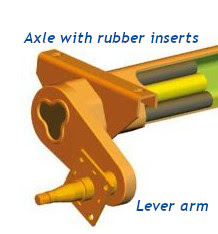Things to be aware of with regard European Caravans
Are you considering buying a caravan or just checking the condition of your vehicle?
European caravans were purposefully designed to be towed by low-powered vehicles on Europe's motorways; they are well-designed for lightweight tow vehicles.
They are very popular in New Zealand but were never designed to be loaded with gear and dragged across logging tracks to a remote location.
Even our good roads are not that smooth, and this will affect the axle.
When checking the axle, look for the lever arm facing downwards and if there is enough room for the arm to travel up and down. See the image below.
Also, check the gap between the top of the tire and the mudguard.

The lever arm is supported at a 25-degree angle by the rubber inserts inside the axle tube. Over time, the rubber inserts become more and more compressed, and the lever arms will no longer point downwards, causing the suspension to become rigid. Therefore, the road vibrations will eventually damage the structure, which leads to cracks forming in the body and moisture penetrating the interior.
Book in for an axle rebuild. Click here
If you already find yourself in this position, don't despair
An axle can be repaired, a refurbished axle will rectify the trailing arm angle so it points downwards and makes the caravan sit much higher off the road surface, and the vehicle will tow better.
As a rough guide, the distance from the bottom of the caravan floor to the road surface measured at the axle should be about 400mm with some manufacturers and about 500mm with others. A refurbished or new axle will usually measure approximately 500mm, depending on the make and model.

Be careful not to overload a European caravan. There is a plate on the side of the entrance door with the weight restrictions printed on it. If you want to know how much your caravan weighs when you are all loaded up and ready to go, just take it to the local waste depot first. They will have a weighing bridge, and for a small fee, you can weigh the caravan for peace of mind.
The following paragraphs examine the consequences of towing a vehicle with a damaged axle.
What happens when the caravan is being towed
Imagine what it might be like sitting in the back of your caravan while being towed down a bumpy NZ road at 90km per hour. (please don't try it!)
Frightening, hey? Imagine what it would be like if the axle was rigid with no flex. The road shock is transferred to the caravan structure and internal cabinetry, which results in the shaking and breaking loose of all the internal fastenings and components. Eventually, you will tow a flexible, leaking container full of loose cabinetry. See this link for just such an example.
For your entertainment, I put in a link to Top Gear so you can see what not to do.
About the caravan chassis construction
The ALKO chassis is not welded (for build convenience); it comprises multiple interchangeable galvanized pressed steel components bolted together. The versatile design enables manufacturers to use the same axle for various models by changing the chassis rail lengths.
The key to this design's strength is that the internal cabinets act as bulkheads, holding the floor, the walls, and the roof together; if the chassis flexes, the forces are transferred through furniture throughout the vehicle.

The tow hitch
The tow hitch and components attached to it are subject to the most significant forces within the caravan.
As the tow vehicle accelerates, decelerates, and turns in different directions, these forces are transferred via the front bulkhead (usually inside the front gas locker) to the rest of the caravan by way of the floor and sidewalls. The front bulkhead is, therefore, an area that is most likely to start moving. To check if your front bulkhead has movement, ensure the four outer steadies are lifted off the ground, and only the jockey wheel is down, or attach it to a tow vehicle. Open the gas locker and look where the bulkhead meets the sidewalls; get someone else to move the caravan up and down using the front wall handles; if there is only the slightest movement at the bulkhead-to-wall connection, your problems have already started.
If there is movement, don't despair.
The vehicle can be repaired; we can find the source of the problem, fix it, and then set the chassis perfectly level to factory settings and reattach the walls to the bulkheads, which will stiffen up the vehicle as it should be.
Conclusion
If you have any doubts about the caravan, its towing, or whether it is wallowing or jerking excessively, you will probably need to have it checked.
If you want to ask questions, you can email us at info@vantagerv.nz

Repairs to the rear exterior panel some sort of plastic , I have a crack in it can it be plastic welded?